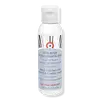What's inside
What's inside
 Key Ingredients
Key Ingredients

No key ingredients
 Benefits
Benefits

 Concerns
Concerns

 Ingredients Side-by-side
Ingredients Side-by-side

Water
Skin ConditioningGlycerin
HumectantGlycereth-26
HumectantSqualane
EmollientSorbitan Oleate
EmulsifyingPhenoxyethanol
PreservativeEthylhexyl Salicylate
UV AbsorberAcrylates/C10-30 Alkyl Acrylate Crosspolymer
Emulsion StabilisingColloidal Oatmeal
AbsorbentMel
EmollientSaccharomyces/Honey Ferment Filtrate
Skin ConditioningChrysanthemum Parthenium Extract
Skin ConditioningSodium Hydroxide
BufferingPotassium Sorbate
PreservativeAvena Sativa Kernel Extract
AbrasiveSodium Benzoate
MaskingCitric Acid
BufferingBeta-Glucan
Skin ConditioningCamellia Sinensis Leaf Extract
AntimicrobialGlycyrrhiza Glabra Root Extract
BleachingPropolis Extract
Skin ConditioningSodium Hyaluronate
HumectantXanthan Gum
EmulsifyingEthylhexylglycerin
Skin ConditioningTetrasodium EDTA
Chlorphenesin
AntimicrobialBenzoic Acid
MaskingSorbic Acid
PreservativeWater, Glycerin, Glycereth-26, Squalane, Sorbitan Oleate, Phenoxyethanol, Ethylhexyl Salicylate, Acrylates/C10-30 Alkyl Acrylate Crosspolymer, Colloidal Oatmeal, Mel, Saccharomyces/Honey Ferment Filtrate, Chrysanthemum Parthenium Extract, Sodium Hydroxide, Potassium Sorbate, Avena Sativa Kernel Extract, Sodium Benzoate, Citric Acid, Beta-Glucan, Camellia Sinensis Leaf Extract, Glycyrrhiza Glabra Root Extract, Propolis Extract, Sodium Hyaluronate, Xanthan Gum, Ethylhexylglycerin, Tetrasodium EDTA, Chlorphenesin, Benzoic Acid, Sorbic Acid
Water
Skin ConditioningPropanediol
SolventPropylene Glycol
HumectantPhenoxyethanol
PreservativeSodium PCA
HumectantSodium Benzoate
MaskingAllantoin
Skin ConditioningChamomilla Recutita Flower Extract
MaskingGlucose
HumectantCucumis Sativus Fruit Extract
EmollientAloe Barbadensis Leaf Juice Powder
Skin ConditioningCamphor
MaskingUrtica Dioica Extract
AstringentEquisetum Arvense Extract
AstringentBetula Alba Leaf Extract
AstringentCI 19140
Cosmetic ColorantPotassium Sorbate
PreservativeCI 14700
Cosmetic ColorantCI 42090
Cosmetic ColorantSodium Hydroxide
BufferingCitric Acid
BufferingWater, Propanediol, Propylene Glycol, Phenoxyethanol, Sodium PCA, Sodium Benzoate, Allantoin, Chamomilla Recutita Flower Extract, Glucose, Cucumis Sativus Fruit Extract, Aloe Barbadensis Leaf Juice Powder, Camphor, Urtica Dioica Extract, Equisetum Arvense Extract, Betula Alba Leaf Extract, CI 19140, Potassium Sorbate, CI 14700, CI 42090, Sodium Hydroxide, Citric Acid
 Reviews
Reviews

Ingredients Explained
These ingredients are found in both products.
Ingredients higher up in an ingredient list are typically present in a larger amount.
Citric Acid is an alpha hydroxy acid (AHA) naturally found in citrus fruits like oranges, lemons, and limes.
Like other AHAs, citric acid can exfoliate skin by breaking down the bonds that hold dead skin cells together. This helps reveal smoother and brighter skin underneath.
However, this exfoliating effect only happens at high concentrations (20%) which can be hard to find in cosmetic products.
Due to this, citric acid is usually included in small amounts as a pH adjuster. This helps keep products slightly more acidic and compatible with skin's natural pH.
In skincare formulas, citric acid can:
While it can provide some skin benefits, research shows lactic acid and glycolic acid are generally more effective and less irritating exfoliants.
Most citric acid used in skincare today is made by fermenting sugars (usually from molasses). This synthetic version is identical to the natural citrus form but easier to stabilize and use in formulations.
Read more about some other popular AHA's here:
Learn more about Citric AcidPhenoxyethanol is a preservative that has germicide, antimicrobial, and aromatic properties. Studies show that phenoxyethanol can prevent microbial growth. By itself, it has a scent that is similar to that of a rose.
It's often used in formulations along with Caprylyl Glycol to preserve the shelf life of products.
Potassium Sorbate is a preservative used to prevent yeast and mold in products. It is commonly found in both cosmetic and food products.
This ingredient comes from potassium salt derived from sorbic acid. Sorbic acid is a natural antibiotic and effective against fungus.
Both potassium sorbate and sorbic acid can be found in baked goods, cheeses, dried meats, dried fruit, ice cream, pickles, wine, yogurt, and more.
You'll often find this ingredient used with other preservatives.
Learn more about Potassium SorbateSodium Benzoate is a preservative. It's used in both cosmetic and food products to inhibit the growth of mold and bacteria. It is typically produced synthetically.
Both the US FDA and EU Health Committee have approved the use of sodium benzoate. In the US, levels of 0.1% (of the total product) are allowed.
Sodium benzoate works as a preservative by inhibiting the growth of bacteria inside of cells. It prevents the cell from fermenting a type of sugar using an enzyme called phosphofructokinase.
It is the salt of benzoic acid. Foods containing sodium benzoate include soda, salad dressings, condiments, fruit juices, wines, and snack foods.
Studies for using ascorbic acid and sodium benzoate in cosmetics are lacking, especially in skincare routines with multiple steps.
We always recommend speaking with a professional, such as a dermatologist, if you have any concerns.
Learn more about Sodium BenzoateSodium Hydroxide is also known as lye or caustic soda. It is used to adjust the pH of products; many ingredients require a specific pH to be effective.
In small amounts, sodium hydroxide is considered safe to use. However, large amounts may cause chemical burns due to its high alkaline.
Your skin has a natural pH and acid mantle. This acid mantle helps prevent harmful bacteria from breaking through. The acid mantle also helps keep your skin hydrated.
"Alkaline" refers to a high pH level. A low pH level would be considered acidic.
Learn more about Sodium HydroxideWater. It's the most common cosmetic ingredient of all. You'll usually see it at the top of ingredient lists, meaning that it makes up the largest part of the product.
So why is it so popular? Water most often acts as a solvent - this means that it helps dissolve other ingredients into the formulation.
You'll also recognize water as that liquid we all need to stay alive. If you see this, drink a glass of water. Stay hydrated!
Learn more about Water